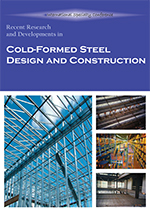Session Dates
24 Aug 2012 - 25 Aug 2012
Abstract
In the AISI Specification for the Design of Cold-formed Steel Structural Members 2007, there are two types of shear planes used to determine the resistance of a bolted connection to block shear failure. When the block shear failure occurs by shear yielding and tensile rupture, the shear failure plane is taken to be the gross shear plane. Conversely, when the block shear failure is deemed to occur by simultaneous shear and tensile ruptures, the shear failure plane is assumed to be the net shear plane. Such an approach is not logical since the shear failure planes should be unique irrespective of the block shear failure mechanism. Through finite element analysis presented in this paper, the shear failure plane is shown to be neither the gross nor the net shear plane, and to be midway between the two shear planes assumed in design specifications. This shear failure plane is termed the active shear plane. The veracity of the active shear area is demonstrated in terms of the ability of the resulting block shear equation to predict the governing failure modes of test specimens consistently, in comparison against the equations assuming the gross and the net shear areas.
Department(s)
Civil, Architectural and Environmental Engineering
Research Center/Lab(s)
Wei-Wen Yu Center for Cold-Formed Steel Structures
Meeting Name
21st International Specialty Conference on Cold-Formed Steel Structures
Publisher
Missouri University of Science and Technology
Document Version
Final Version
Rights
© 2012 Missouri University of Science and Technology, All rights reserved.
Document Type
Article - Conference proceedings
File Type
text
Language
English
Recommended Citation
Clements, Drew D. A. and Teh, Lip H., "Active Shear Planes in Block Shear Failure of Bolted Connections" (2012). CCFSS Proceedings of International Specialty Conference on Cold-Formed Steel Structures (1971 - 2018). 1.
https://scholarsmine.mst.edu/isccss/21iccfss/21iccfss-session9/1
Active Shear Planes in Block Shear Failure of Bolted Connections
In the AISI Specification for the Design of Cold-formed Steel Structural Members 2007, there are two types of shear planes used to determine the resistance of a bolted connection to block shear failure. When the block shear failure occurs by shear yielding and tensile rupture, the shear failure plane is taken to be the gross shear plane. Conversely, when the block shear failure is deemed to occur by simultaneous shear and tensile ruptures, the shear failure plane is assumed to be the net shear plane. Such an approach is not logical since the shear failure planes should be unique irrespective of the block shear failure mechanism. Through finite element analysis presented in this paper, the shear failure plane is shown to be neither the gross nor the net shear plane, and to be midway between the two shear planes assumed in design specifications. This shear failure plane is termed the active shear plane. The veracity of the active shear area is demonstrated in terms of the ability of the resulting block shear equation to predict the governing failure modes of test specimens consistently, in comparison against the equations assuming the gross and the net shear areas.



